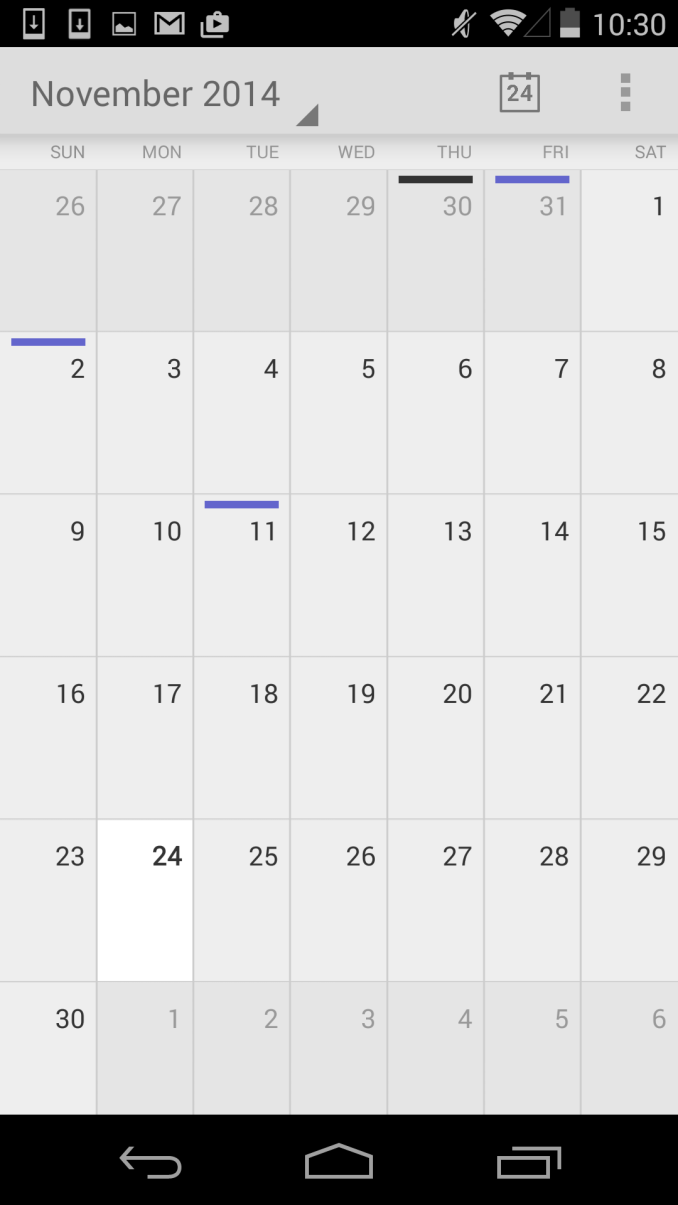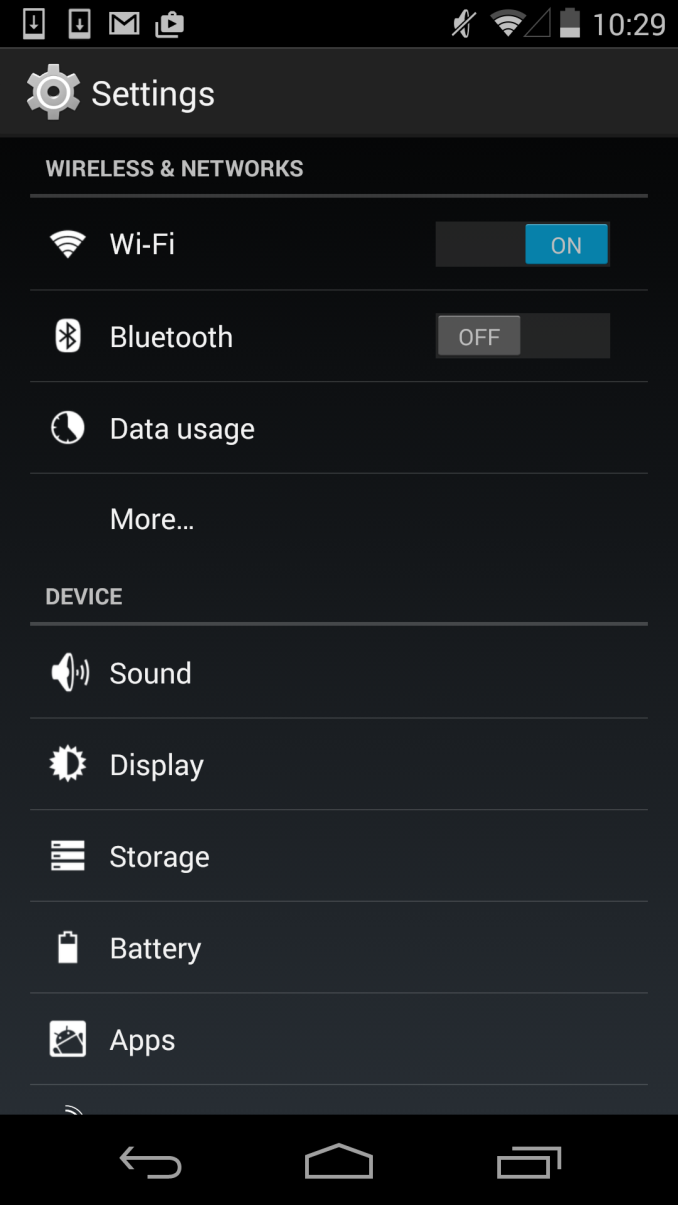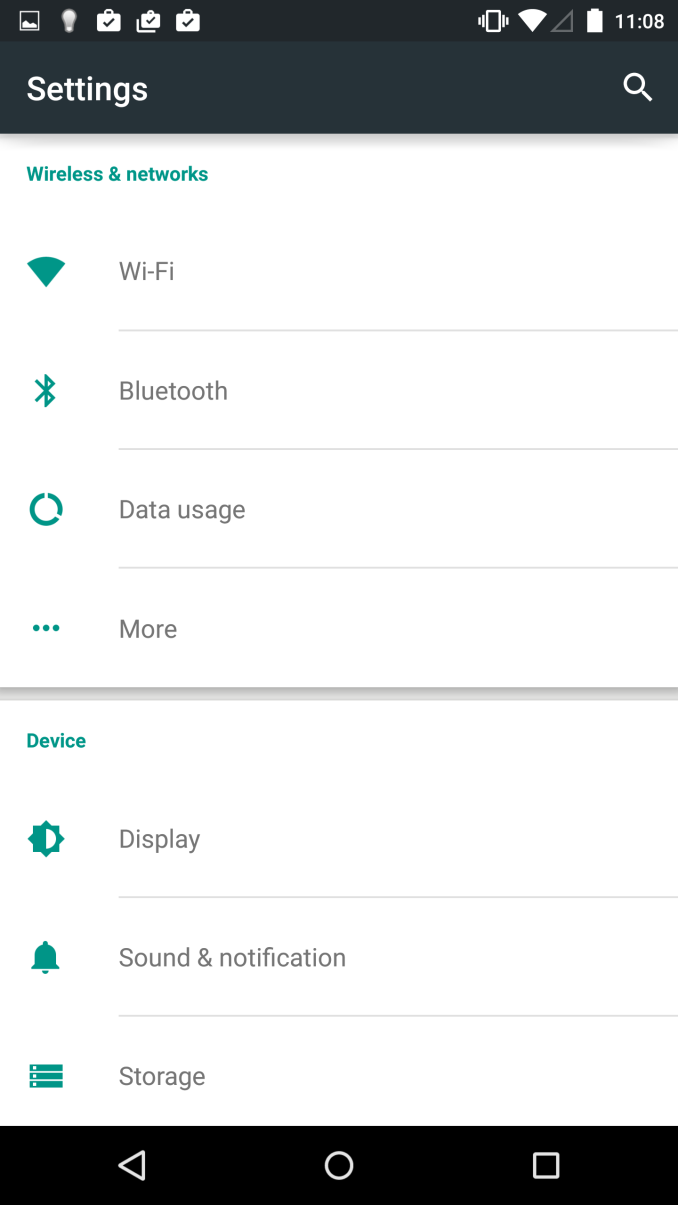The Android 5.0 Lollipop Review
by Brandon Chester on December 1, 2014 10:00 AM EST- Posted in
- Smartphones
- Android
- Tablets
- Android 5.0
Material Design
A good place to begin before discussing the operating system itself is to explain what exactly "Material Design" is. The term comes up a lot throughout the course of the review, which makes sense given how the biggest changes that users will see when moving from KitKat to Lollipop will be because of Material Design. Material Design is a set of design principles, and contained within them is something of a mission statement about Google's approach to services across multiple platforms. Material Design is definitely not Google's first big change to the Android interface, but this time I'm actually very confident that it will be the last we see for a very long time. I'm very impressed by the work Google has done to create an interface that looks and feels modern, simple, and beautiful. Before getting into what Material Design looks and acts like, I'd like to address and give my thoughts about Google's previous style of interface design which was called Holo.
To me, Holo always seemed like a transitional type of interface. Google had just brought on Matías Duarte, but as someone whose first smartphone was a Palm Pre, I didn't feel his influence anywhere at all. I think that Holo was a definite improvement over the previous Android interface, but that isn't really saying much. In my opinion, it still didn't feel coherent or look visually appealing. For example, if you showed me the two screens above without the status bar and navigation buttons, I would be hard pressed to tell you that they're from the same operating system. They don't share a single common interface element. The lack of color and use of grey was also questionable. While some users protest the heavy use of white in many modern interfaces, to me the grey that was commonly used in Holo Light applications was analogous to a dirty white cloth. The lacking color also made applications feel rather dull and lifeless, and I almost wondered if it was an effort to try and mask the fact that phones were shipping with either under-saturated or over-saturated displays by just having almost no color at all.
With my disappointment in Google's new interface, I was worried that it would just be something I would have to deal with for many years. Fortunately, less than one year after Android Ice Cream Sandwich was released, we were given a glimpse of the beginnings of a new type of design that was distinctly not Holo. It was in a feature called Google Now which launched with Android 4.1, and that many people now use everyday. This application used bright white cards to display relevant information, and had a much heavier use of color than any other applications that shipped along with Android. While at the time this could have been dismissed as the most obvious way to make an application that is constantly displaying and updating information for the user, in hindsight it was clearly the beginning of a new type of design being practiced at Google. It was still immature, lacking the animations, drop shadows, and dynamic nature of Material Design, but it began the dissolution of the Holo interface that had just been introduced.
Finally with the end of Holo, comes the beginning of Material. When Google gave a sneak peek of the new interface for Lollipop at Google IO I was very excited by what I saw seeing. The basic idea of the cards in Google Now had been applied to the entire operating system, and expanded upon in ways that I hadn't expected but have been pleasantly surprised by. As you can see above, both applications display the sections of the interface on white cards that float above the background and cast slight shadows. There's also a much greater use of color, and a better use of screen real estate by dividing the application into multiple sections which can be seen in the new Calendar application. The Settings application is actually a bad example in this regard, as the increased spacing means the main page fits less on screen than before, but this is an exception and I included it primarily to show the contrast between new and old.
Material Design is based upon the ideas of paper, lighting, shadows, depth, and color. While this sounds a lot like the skeuomorphic interface of previous versions of iOS, Material Design doesn't limit itself based on the actual limits of physical items like paper, and it doesn't go to the point where applications are merely digital recreations of real world objects. There's also a heavy use of animations. Everything you touch seems to respond with an elegant animation, and the different cards in the interface can expand, contract, and stack atop one another to create an extremely dynamic feel. It is truly hard to explain, and it's really something that needs to be used to be fully understood.
The last thing to say about Material Design is how it represents more than just a way to design applications. Like I said earlier, within Material Design is a mission statement about Google's approach to services across multiple platforms. Although I've discussed it within the context of the Android platform, Material Design is going to be what you see in Google's applications across every platform. From web apps, to Android, to Chrome, to iOS applications, you will see a consistent style of design that adapts to different display sizes, use models, and methods of input. Overall this is a great step forward in making Google's services consistent across all devices, but I think in the context of iOS applications Google may be going a bit too far by ignoring the design guidelines of that platform in favor of their own.














126 Comments
View All Comments
Impulses - Tuesday, December 2, 2014 - link
I actually prefer dragging twice to the top right button, but that's probably because I use my phone primarily with my left hand. Always thought the quick settings button was much too close to the clear all button tho, despite only hitting clear all by mistake once or twice over the last year or so. I do agree some of the other card stacking and UI choices are questionable tho.toyotabedzrock - Monday, December 1, 2014 - link
Oh and can Google explain why Chrome crashes when sharing to Google Plus via the mobile browser interface? Or why the plus app shate function causes every other app to crash from memory depletion? Also Google search inexplicably crashes on my Nexus 5.Salty Wagyu - Monday, December 1, 2014 - link
Tapatalk has the worst jank, even ART hasn't helped much in this case.sonicmerlin - Monday, December 1, 2014 - link
This talk in Google's 2014 I/O event is very relevant: https://www.youtube.com/watch?v=3TtVsy98cesThe speaker talks about the issues of Android's render thread priority causing lag, and how google worked to fix it in lollipop. I think it starts about 19:30 in.
My main question though is how browsers are affected. iOS and WP browsers scroll every webpage with pixel perfect smoothness, where Android has always lagged and stuttered on heavier web pages. Does Lollipop fix this, or will developers have to code their browsers to take advantage of Lollipop?
lukechip - Monday, December 1, 2014 - link
Lollipop is OK, but I preferred KitKat on my Nexus 10. On Lollipop is seems to take longer / more steps to do the same things compared with KitKat. For example, switching users used to involve:1/ swipe down settings
2/ click on my avatar
3/ enter my PIN
Now it invovles:
1/ swipe down notification tray
2/ click on user icon
3/ select my avatar
4/ drag up lock icon
5/ enter my PIN
The added steps add zero value to my experience. It's just plain poor.
Egg - Monday, December 1, 2014 - link
Frankly, I've been disappointed with Lollipop on my Nexus 5. First thing I noticed was highly visible frame drops swiping between Google Now and the home screen. Dashclock no longer functions. I need to swipe twice to get to the quick shortcuts... why? Meanwhile I haven't seen any improvement in the camera, which is slow to focus even in well lit scenarios... wasn't Camera2 supposed to fix this?Egg - Monday, December 1, 2014 - link
Just tested with GPU profiling, I can routinely get spikes to appear. Yikes!(Also, Google Now's undo toast is not full caps like the updated Photos app undo toast.)
tuxRoller - Monday, December 1, 2014 - link
I really, really wish art had delivered what was promised, but for my sample of three nexus devices (n4,n5,n7-2013) it has unambiguously made things worse. All of these devices were installed using the factory image, and two were fully wiped. It's just awful. Load times are longer. The interface is more janky than its ever been. Battery is pretty much unchanged, however.Google would've really benefited from an additional developer release so as to avoid these issues.
Lavkesh - Tuesday, December 2, 2014 - link
I have infact experienced a drop in battery life. I used to have a screen on time of little over 3 hours on Kit Kat but I havent been able to touch 3 hours so far with Lollipop.Lavkesh - Monday, December 1, 2014 - link
There are still a few areas where the animations do not even do close to 30 fps, let alone 60. The new message application is one example when you tap a conversation and it opens up. That said I do not know why the animations on my iPhone 4s feel smoother. Are they rendering it higher than 60 fps or is it physics?